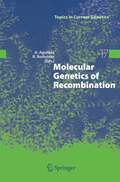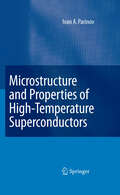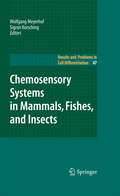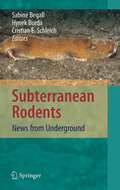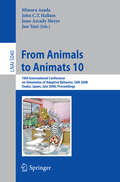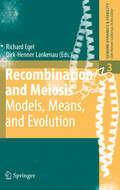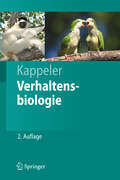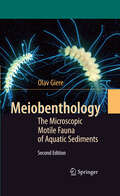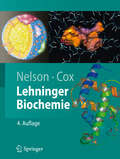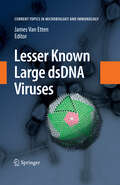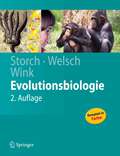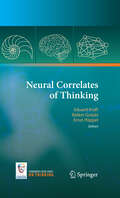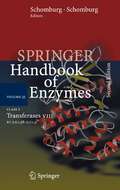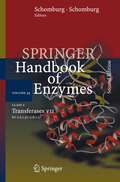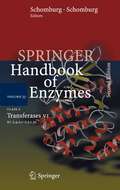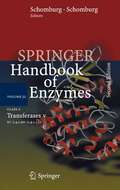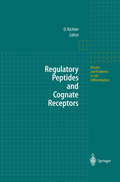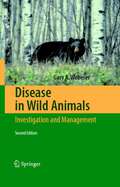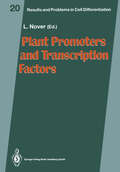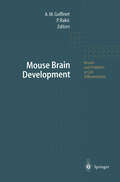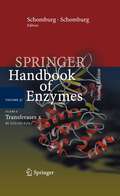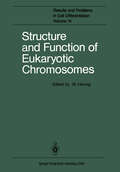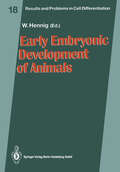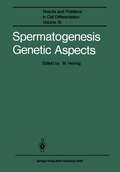- Table View
- List View
Molecular Genetics of Recombination (Topics in Current Genetics #17)
by Andrés Aguilera Rodney RothsteinThis work offers a fascinating insight into a crucial genetic process. Recombination is, quite simply, one of the most important topics in contemporary biology. This book is a totally comprehensive treatment of the subject, summarizing all existing views on the topic and at the same time putting them into context. It provides in-depth and up-to-date analysis of the chapter topics, and has been written by international experts in the field.
Microstructure and Properties of High-Temperature Superconductors
by I. A. ParinovThis book provides a comprehensive presentation of all types of HTSC and includes a broad overview on HTSC computer simulations and modeling. Especial attention is devoted to the Bi-Sr-Ca-Cu-O and Y-Ba-Cu-O families that today are the most perspective for applications. The book includes a great number of illustrations and references. The monograph is addressed to students, post-graduate students and specialists, taking part in the development, preparation and researching of new materials.
Chemosensory Systems in Mammals, Fishes, and Insects (Results and Problems in Cell Differentiation #47)
by Sigrun Korsching Wolfgang MeyerhofThe sense of smell has an essential role in locating food, detecting predators, navigating, and communicating social information. Accordingly, the olfactory system has evolved complex repertoires of receptors to face these problems. Although the sense of taste has less far-reaching tasks, they are every bit as essential for the animals well-being, allowing it to reject toxic materials and to select nutritionally valuable food. The last decade has seen a massive advance in understanding the molecular logic of chemosensory information processing, beyond that already achieved in the rst few years following Linda Bucks discovery of odorant receptors. Shortly afterwards, the major principles of olfactory representation had been established in mammals as the one neuron/ one receptor rule and the convergence of neurons, which express the same receptor, onto individual modules in the olfactory bulb. In recent years, such studies have been extended to lower vertebrates, including shes and other phyla, i. e. , arthropods, worms, and insects, showing both the general validity of these concepts and some exceptions to the rule. In parallel, hallmarks of the molecular logic of taste sensation have been deciphered and found to differ in interesting ways from those of smell sensation.
Subterranean Rodents: News from Underground
by Sabine Begall Hynek Burda Cristian Eric SchleichSubterranean Rodents presents achievements from recent years of research on these rodents, divided into five sections: ecophysiology; sensory ecology; life histories, behavioural ecology and demography; environmental and economical impact; molecular ecology and evolution. It is a must for all researchers working in this field and will be of interest to zoologists, physiologists, morphologists, ecologists, and evolutionary biologists.
From Animals to Animats 10: 10th International Conference on Simulation of Adaptive Behavior, SAB 2008, Osaka, Japan, July 7-12, 2008, Proceedings (Lecture Notes in Computer Science #5040)
by Minoru Asada John C. T. Hallam Jean-Arcady Meyer Jun TaniThis book constitutes the refereed proceedings of the 10th International Conference on Simulation of Adaptive Behavior, SAB 2008, held in Osaka, Japan in July 2008. The 30 revised full papers and 21 revised poster papers presented were carefully reviewed and selected from 110 submissions. The papers are organized in topical sections on the animat approach to adaptive behaviour, evolution, navigation and internal world models, perception and control, learning and adaptation, cognition, emotion and behaviour, collective and social behaviours, adaptive behaviour in language and communication, and applied adaptive behaviour.
Recombination and Meiosis: Models, Means, and Evolution (Genome Dynamics and Stability #3)
by Richard Egel Dirk-Henner LankenauOnce per life cycle, mitotic nuclear divisions are replaced by meiosis I and II – reducing chromosome number from the diploid level to a haploid genome and recombining chromosome arms by crossing-over. In animals, all this happens during formation of eggs and sperm – in yeasts before spore formation. The mechanisms of reciprocal exchange at crossover/chiasma sites are central to mainstream meiosis. To initiate the meiotic exchange of DNA, surgical cuts are made as a form of calculated damage that subsequently is repaired by homologous recombination. These key events are accompanied by ancillary provisions at the level of chromatin organization, sister chromatid cohesion and differential centromere connectivity. Great progress has been made in recent years in our understanding of these mechanisms. Questions still open primarily concern the placement of and mutual coordination between neighboring crossover events. Of overlapping significance, this book features two comprehensive treatises of enzymes involved in meiotic recombination, as well as the historical conceptualization of meiotic phenomena from genetical experiments. More specifically, these mechanisms are addressed in yeasts as unicellular model eukaryotes. Furthermore, evolutionary subjects related to meiosis are treated.
Verhaltensbiologie (Springer-Lehrbuch)
by Peter KappelerFressen und gefressen werden, Paarungspartner finden und Junge erfolgreich aufziehen. Anhand dieser vier Grundprobleme der Tierwelt stellt der Autor die Prinzipien der Verhaltenbiologie klar, übersichtlich und anhand aktueller Beispiele dar. Die Neuauflage enthält zahlreiche neue Abbildungen, die den Text noch besser illustrieren. Die theoretischen Konzepte wurden deutlicher herausgearbeitet und der Inhalt um neue Abschnitte zur Kognitionsforschung und zum Sozialverhalten erweitert.
Meiobenthology: The Microscopic Motile Fauna of Aquatic Sediments
by Olav GiereMeiobenthology is the science of the tiny animals that live in huge numbers in all aquatic sediments. This fully revised and enlarged second edition emphasizes new discoveries and developments in this field. Major progress has been made in three general areas: - Systematics, diversity and distribution, - Ecology, food webs, and energy flow, - Environmental aspects, including studies of anthropogenic impacts. The meiobenthos of polar and tropical regions, deep-sea bottoms and hydrothermal vents are now studied in more detail. The high number of species found to survive under such extreme conditions puts them at the forefront of biodiversity studies. Molecular screening methods enable large numbers to be analyzed upon applying reasonable effort. The aim of this book is to synthesize these modern scientific achievements such that meiobenthology can play a key role in aquatic research and in assessing the health of our environment.
Lehninger Biochemie (Springer-Lehrbuch)
by David Nelson Michael CoxSeit einem Vierteljahrhundert setzt der „Lehninger“ Maßstäbe als Lehrbuch der Biochemie - mit einer klaren Sprache, sorgfältigen Illustrationen, spannenden Exkursen und Beispielen aus der aktuellsten Forschung. So werden in der neuen Auflage sowohl die Grundlagen betont als auch der Reiz der aktuellen Forschung und ihrer Perspektiven vermittelt. Neben den neuesten Fortschritten und neuen Methoden in der Biochemie wurden noch mehr medizinisch relevante Beispiele aufgenommen. Ein Schwerpunkt der neuen Auflage, der sich über alle relevanten Kapitel verteilt, ist Diabetes. Über 100 neue Aufgaben am Ende der Kapitel bieten den Studierenden die Möglichkeit, das Gelernte einzuüben. Dieses Buch ist die Übersetzung der 5. amerikanischen Auflage.
Lesser Known Large dsDNA Viruses (Current Topics in Microbiology and Immunology #328)
by James L. Van EttenSeveral large dsDNA-containing viruses such as poxviruses (smallpox) and herpes viruses are well known among the scientific community, as well as the general populace, because they cause human diseases. The large dsDNA insect-infecting baculoviruses are also well known in the scientific community because they are used both as biological control agents and as protein expression systems. However, there are other large dsDNA-containing viruses, including the giant 1.2 Mb mimivirus, which are less well known despite the fact that all of them play important roles in every day life. Seven of these virus families are reviewed in this book.
Evolutionsbiologie (Springer-Lehrbuch)
by Volker Storch Ulrich WelschVom Molekül zur Vielfalt des Lebens: In fünf großen Kapiteln stellen die Autoren die Geschichte der Evolutionsbiologie sowie den Ablauf und die molekularen Grundlagen der Evolution unter besonderer Berücksichtigung des Menschen dar. Die Neuauflage wurde gründlich überarbeitet und aktualisiert, viele Abbildungen neu angefertigt. In zahlreichen Exkursen, teilweise von eingeladenen Wissenschaftlern verfasst, werden einzelne, besonders aktuelle Themen erörtert.
Neural Correlates of Thinking (On Thinking)
by Eduard Kraft Balázs Gulyás Ernst PöppelThe advances in neuroimaging technologies have led to substantial progress in understanding the neural mechanisms of cognitive functions. Thinking and reasoning have only recently been addressed by using neuroimaging techniques. The present book comprehensively explores current approaches and contributions to understanding the neural mechanisms of thinking in a concise and readable manner. It provides an insight into the state of the art and the potentials, but also the limitations of current neuroimaging methods for studying cognitive functions. The book will be a valuable companion for everyone interested in one of the most fascinating topics of cognitive neuroscience.
Class 2 Transferases VIII: EC 2.6.1.58 - 2.7.1.37 (Springer Handbook of Enzymes #35)
by A. ChangThe Springer Handbook of Enzymes provides concise data on some 5,000 enzymes sufficiently well characterized – and here is the second, updated edition. Their application in analytical, synthetic and biotechnology processes as well as in food industry, and for medicinal treatments is added. Data sheets are arranged in their EC-Number sequence. The new edition reflects considerable progress in enzymology: the total material has more than doubled, and the complete 2nd edition consists of 39 volumes plus Synonym Index. Starting in 2009, all newly classified enzymes are treated in Supplement Volumes.
Class 2 Transferases VII: EC 2.5.1.31 - 2.6.1.57 (Springer Handbook of Enzymes #34)
by A. ChangThe Springer Handbook of Enzymes provides concise data on some 5,000 enzymes sufficiently well characterized – and here is the second, updated edition. Their application in analytical, synthetic and biotechnology processes as well as in food industry, and for medicinal treatments is added. Data sheets are arranged in their EC-Number sequence. The new edition reflects considerable progress in enzymology: the total material has more than doubled, and the complete 2nd edition consists of 39 volumes plus Synonym Index. Starting in 2009, all newly classified enzymes are treated in Supplement Volumes.
Class 2 Transferases VI: 2.4.2.1 - 2.5.1.30 (Springer Handbook of Enzymes #33)
by A. ChangThe Springer Handbook of Enzymes provides concise data on some 5,000 enzymes sufficiently well characterized – and here is the second, updated edition. Their application in analytical, synthetic and biotechnology processes as well as in food industry, and for medicinal treatments is added. Data sheets are arranged in their EC-Number sequence. The new edition reflects considerable progress in enzymology: the total material has more than doubled, and the complete 2nd edition consists of 39 volumes plus Synonym Index. Starting in 2009, all newly classified enzymes are treated in Supplement Volumes.
Class 2 Transferases V: 2.4.1.90 - 2.4.1.232 (Springer Handbook of Enzymes #32)
by A. ChangThe Springer Handbook of Enzymes provides concise data on some 5,000 enzymes sufficiently well characterized – and here is the second, updated edition. Their application in analytical, synthetic and biotechnology processes as well as in food industry, and for medicinal treatments is added. Data sheets are arranged in their EC-Number sequence. The new edition reflects considerable progress in enzymology: the total material has more than doubled, and the complete 2nd edition consists of 39 volumes plus Synonym Index. Starting in 2009, all newly classified enzymes are treated in Supplement Volumes.
Regulatory Peptides and Cognate Receptors (Results and Problems in Cell Differentiation #26)
by Dietmar RichterDisease in Wild Animals: Investigation and Management
by Gary A. WobeserGary Wobeser's successful book from 1994 has been completely updated and enlarged in a new second edition. An in-depth overview of the available techniques for the investigation and management of disease in free-ranging animals is provided. The subjects are illustrated with examples drawn from around the world, with emphasis on the special requirements involved in working with wild animals. The book draws on the author’s training as a wildlife biologist.
Plant Promoters and Transcription Factors (Results and Problems in Cell Differentiation #20)
by Lutz NoverThe control of plant gene expression at the transcriptional level is the main subject of this volume. Genetics, molecular biology and gene technology have dramatically improved our knowledge of this event. The functional analysis of promoters and transcription factors provides more and more insights into the molecular anatomy of initiation complexes assembled from RNA polymerase and the multiplicity of helper and control proteins. Formation of specific DNA-protein complexes - activating or repressing transcription - is the crux of developmental or environmental control of gene expression. The book presents an up-to-date, critical overview of this rapidly advancing field.
Mouse Brain Development (Results and Problems in Cell Differentiation #30)
by Andre M. Goffinet Pasko RakicOur understanding of the molecular mechanisms involved in mammalian brain development remains limited. However, the last few years have wit nessed a quantum leap in our knowledge, due to technological improve ments, particularly in molecular genetics. Despite this progress, the available body of data remains mostly phenomenological and reveals very little about the grammar that organizes the molecular dictionary to articulate a pheno type. Nevertheless, the recent progress in genetics will allow us to contem plate, for the first time, the integration of observation into a coherent view of brain development. Clearly, this may be a major challenge for the next century, and arguably is the most important task of contemporary develop mental biology. The purpose of the present book is to provide an overview that syn thesizes up-to-date information on selected aspects of mouse brain devel opment. Given the format, it was not possible to cover all aspects of brain development, and many important subjects are missing. The selected themes are, to a certain extent, subjective and reflect the interests of the contributing authors. Examples of major themes that are not covered are peripheral nervous system development, including myelination, the development of the hippocampus and several other CNS structures, as well as the developmental function of some important morphoregulatory molecules.
Class 2 Transferases X: EC 2.7.1.113 - 2.7.5.7 (Springer Handbook of Enzymes #37)
by A. ChangThe Springer Handbook of Enzymes provides concise data on some 5,000 enzymes sufficiently well characterized – and here is the second, updated edition. Their application in analytical, synthetic and biotechnology processes as well as in food industry, and for medicinal treatments is added. Data sheets are arranged in their EC-Number sequence. The new edition reflects considerable progress in enzymology: the total material has more than doubled, and the complete 2nd edition consists of 39 volumes plus Synonym Index. Starting in 2009, all newly classified enzymes are treated in Supplement Volumes.
Structure and Function of Eukaryotic Chromosomes (Results and Problems in Cell Differentiation #14)
by Wolfgang HennigThis book presents an overview of various aspects of chromosome research, written by leading experts of the respective fields, combining classic and recent molecular biological results. The variety and comprehensiveness make it a handbook of chromosome research for all scientists, teachers and graduate students interested in this field. Dieses Buch faßt die unterschiedlichen Aspekte der Chromosomenforschung in Beiträgen von führenden Wissenschaftlern zusammen, wobei die klassischen Erkenntnisse mit neuesten Forschungsdaten zu einem umfassenden Überblick über das Gebiet kombiniert werden.
Early Embryonic Development of Animals (Results and Problems in Cell Differentiation #18)
by Wolfgang HennigFour of the major animal systems studied for the mechanisms of their early embryonic development are treated in this volume. The articles address the specific questions studied in the various systems, discuss the fundamental questions raised by the particular organism and explain the techniques used to find answers to these questions. Questions of patternformation, early organogenesis and the genetics of the early development arecovered as well as the question of parental imprinting phenomena in mammals which are important for the early differentiation. The development of the mouse, Drosophila, Caenorhabditis and the zebrafish is emphasized by leading experts of their fields, and current problems in each system are exposed. For the zebrafish the advantages of this new system for developmental biology studies are summarized and discussed in their values, while in the other system the emphasis is laid on one of the actual field of research.
Spermatogenesis Genetic Aspects (Results and Problems in Cell Differentiation #15)
by Wolfgang HennigSpermatogenesis is one of the fundamental but at the same time also one of the most complex differentiation processes in higher eukaryotes. For a long time the development of spermatozoa has been considered as related solely to the needs of transfer of the paternal genome into the egg. Other paternal contributions to the development of the embryo were not seriously considered. Only recently has it become evident, from studies of mouse embryonic development by Solter and colleagues, that also the paternal genome carries regulatory information into the zygote since the development of a mouse embryo requires the presence of the maternal as well as of the paternal pronucleus. This means that we have to pay more attention to the development of male gametes, since the imprinting of the paternal genome obviously required for the early embryonic development must occur during male gamete development. Despite the fundamental character of sperm development as a cellular differentiation process, no coherent concepts for studies of this process exist. Many morphological, and in particular ultrastructural, details of sperm devel opment and sperm structure are known, but this knowledge has not been assembled into a consistent picture reflecting the basic features of this differ entiation process. One of the reasons for the failure to construct such a picture is the fact that also the genetics of sperm development is poorly developed. For elaborating concepts of early embryonic development the study of mutants has been, and still is, indispensible.
Pedestrian and Evacuation Dynamics 2005
by Nathalie Waldau Peter Gattermann Hermann Knoflacher Michael SchreckenbergDue to an increasing number of reported catastrophes all over the world, the safety especially of pedestrians today, is a dramatically growing field of interest, both for practitioners as well as scientists from various disciplines. The questions arising mainly address the dynamics of evacuating people and possible optimisations of the process by changing the architecture and /or the procedure.
